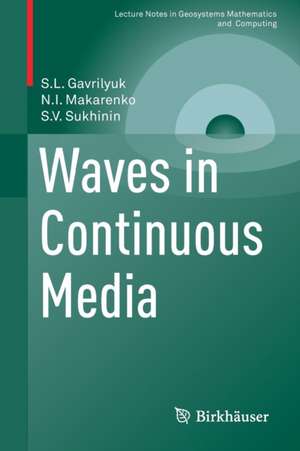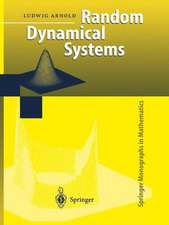Waves in Continuous Media: Lecture Notes in Geosystems Mathematics and Computing
Autor S. L. Gavrilyuk, N.I. Makarenko, S.V. Sukhininen Limba Engleză Paperback – 3 feb 2017
Chapter 3 deals with surface and internal waves in an incompressible fluid. The efficiency of mathematical methods is demonstrated on a hierarchy of approximate submodels generated from the Euler equations of homogeneous and non-homogeneous fluids.
The self-contained presentations of the material is complemented by 200+ problems of different level of difficulty, numerous illustrations, and bibliographical recommendations.
Preț: 571.10 lei
Preț vechi: 671.87 lei
-15% Nou
Puncte Express: 857
Preț estimativ în valută:
109.31€ • 118.78$ • 91.88£
109.31€ • 118.78$ • 91.88£
Carte tipărită la comandă
Livrare economică 21 aprilie-05 mai
Preluare comenzi: 021 569.72.76
Specificații
ISBN-13: 9783319492766
ISBN-10: 3319492764
Pagini: 141
Ilustrații: VIII, 141 p. 15 illus.
Dimensiuni: 155 x 235 x 8 mm
Greutate: 2.41 kg
Ediția:1st ed. 2017
Editura: Springer International Publishing
Colecția Springer
Seria Lecture Notes in Geosystems Mathematics and Computing
Locul publicării:Cham, Switzerland
ISBN-10: 3319492764
Pagini: 141
Ilustrații: VIII, 141 p. 15 illus.
Dimensiuni: 155 x 235 x 8 mm
Greutate: 2.41 kg
Ediția:1st ed. 2017
Editura: Springer International Publishing
Colecția Springer
Seria Lecture Notes in Geosystems Mathematics and Computing
Locul publicării:Cham, Switzerland
Cuprins
1. Hyperbolic waves.- 2. Dispersive waves.- 3. Water waves.
Recenzii
“This book is a graduate level text based upon a lecture course on waves in continuous media with particular emphasis on fluid media. It is aimed at students of applied mathematics, mechanics and geophysics. … Waves in a stratified fluid and stability of such waves are also discussed. A number of instructive examples and exercises are given that may be useful for the targeted audience.” (Fiazud Din Zaman, zbMATH 1364.76003, 2017)
Notă biografică
Sergey Gavrilyuk is professor at the Aix-Marseille III University, Marseille, France
Nikolai MAKARENKO is professor at the Lavrentyev Institute of Hydrodynamics Siberian Branch of the Russian Academy, Novosibirsk, Russia
Sergey SUKHININ is professor at the Lavrentyev Institute of Hydrodynamics Russian Academy of Sciences, Novosibirsk, Russia
Nikolai MAKARENKO is professor at the Lavrentyev Institute of Hydrodynamics Siberian Branch of the Russian Academy, Novosibirsk, Russia
Sergey SUKHININ is professor at the Lavrentyev Institute of Hydrodynamics Russian Academy of Sciences, Novosibirsk, Russia
Textul de pe ultima copertă
Starting with the basic notions and facts of the mathematical theory of waves illustrated by numerous examples, exercises, and methods of solving typical problems Chapters 1 & 2 show e.g. how to recognize the hyperbolicity property, find characteristics, Riemann invariants and conservation laws for quasilinear systems of equations, construct and analyze solutions with weak or strong discontinuities, and how to investigate equations with dispersion and to construct travelling wave solutions for models reducible to nonlinear evolution equations.
Chapter 3 deals with surface and internal waves in an incompressible fluid. The efficiency of mathematical methods is demonstrated on a hierarchy of approximate submodels generated from the Euler equations of homogeneous and non-homogeneous fluids.
The self-contained presentations of the material is complemented by 200+ problems of different level of difficulty, numerous illustrations, and bibliographical recommendations.
Chapter 3 deals with surface and internal waves in an incompressible fluid. The efficiency of mathematical methods is demonstrated on a hierarchy of approximate submodels generated from the Euler equations of homogeneous and non-homogeneous fluids.
The self-contained presentations of the material is complemented by 200+ problems of different level of difficulty, numerous illustrations, and bibliographical recommendations.
Caracteristici
This book aims to promote a problem solving approach to teaching the wave propagation in continuous media This book contains more than 200 problems covering mostly compressible fluid mechanics and surface wave propagation in incompressible (homogeneous or non) fluids Answers each problem considered as a new material to deeper understanding qualitative and quantitative properties of wave models rather than a simple application of the methods presented



















